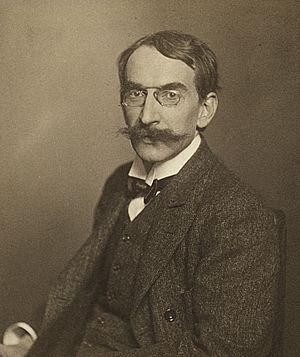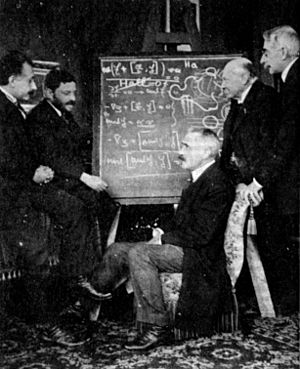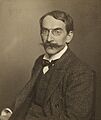Pierre Weiss facts for kids
Quick facts for kids
Pierre Weiss
|
|
|---|---|
 |
|
| Born | 25 March 1865 |
| Died | 24 October 1940 (aged 75) |
| Nationality | French |
| Known for | Curie–Weiss law Mean field theory Magnetic domain Weiss magneton Magnetocaloric effect Cotton-Weiss method |
| Awards | Commandeur of the Legion of Honor (1935) |
| Scientific career | |
| Fields | Physics, magnetism |
| Institutions | University of Rennes, University of Lyon, ETH Zurich, University of Strasbourg, |
| Thesis | Recherches sur l'aimantation de la magnétite cristallisée et de quelques alliages de fer et d’antimoine (1896) |
| Doctoral advisor | Jules Violle Marcel Brillouin |
| Doctoral students | Louis Néel |
Pierre-Ernest Weiss (born March 25, 1865, in Mulhouse; died October 24, 1940, in Lyon) was a French physicist. He was an expert in the field of magnetism. He made many important discoveries about how magnets work.
In 1907, Weiss developed the domain theory of ferromagnetism. This theory helps explain why some materials are strongly magnetic. Two important ideas named after him are Weiss domains and the Weiss magneton. He also created the molecular or mean field theory. This theory led to the discovery of the Curie–Weiss law, which describes how magnetism changes with temperature. Along with Auguste Piccard, Pierre Weiss was one of the first to discover the magnetocaloric effect in 1917. This effect shows how a material's temperature can change when a magnetic field is applied.
Pierre Weiss's experiments helped create some of the strongest electromagnets in the early 20th century. He worked at several universities, including Rennes, Lyon, ETH Zurich, and Strasbourg. At these places, he started famous laboratories for physics research.
Contents
Early Life and Education
Pierre Weiss was born in Mulhouse, France, on March 25, 1865. He was the first child of Emile Weiss and Ida Schlumberger. When he was five, his home region, Alsace, became part of Germany. Pierre finished his early studies in Mulhouse.
He then went to the Swiss Federal Institute of Technology in Zurich (ETH). In 1887, he earned a diploma as a mechanical engineer. He was the top student in his class. When he became an adult, he chose to become a French citizen instead of a German one.
In 1888, he prepared for the entry exam to the École Normale Supérieure (ENS) in Paris. He was accepted into this famous school. After studying at ENS, he stayed there as a teaching assistant. At the same time, he earned degrees in physical and mathematical sciences from the Faculty of Sciences of Paris. In Paris, he met many future famous scientists. These included mathematicians like Élie Cartan and physicists like Jean Perrin.
Academic Career and Discoveries
In 1895, Pierre Weiss became a lecturer at the University of Rennes. The next year, in 1896, he earned his doctorate in physical sciences. His research was about how magnetite and some iron alloys become magnetized. His professors, Jules Violle and Marcel Brillouin, guided his work.
In October 1896, Pierre Weiss married Jane Rancès in Paris. Their daughter, Nicole, later married the French mathematician Henri Cartan.
Weiss supported Alfred Dreyfus, who was also from Alsace. This was a difficult time in France. Because of this, Weiss decided to move and teach at the University of Lyon in 1899.

Even though he was a professor in Lyon, he accepted an offer from ETH Zurich in 1902. He became a physics professor and director of the Institute of Physics there. In 1907, he published an important paper on ferromagnetism. In this paper, he introduced the idea of the molecular field. This was an early version of the mean field theory. While in Zurich, he met other famous scientists like Albert Einstein and Peter Debye.
During World War I, Weiss returned to France. He worked with Aimé Cotton to develop a system to track artillery using sound. This was known as the Cotton-Weiss method.
Return to Strasbourg
In 1919, Strasbourg became part of France again. The University of Strasbourg needed to be rebuilt and reconnected to the French system. Pierre Weiss chose to become a physics professor there. He also became the director of the Institute of Physics. He founded a new institute in Strasbourg specifically for magnetism research. This was similar to the one he had started in Zurich.
He brought many of his colleagues from Zurich to Strasbourg. These included Gabriel Foëx and Robert Forrer. Some of Weiss's notable students became famous scientists themselves. These included Swiss explorer Auguste Piccard and French Nobel laureate Louis Néel.
According to Francis Perrin, a friend's son, Weiss was a tall, thin man. He was very polite and had an elegant look. His hair and large mustache turned white when he was still quite young.
Louis Néel, a young scientist, joined Weiss's lab in 1928 to work on his thesis. He became Weiss's assistant in 1932. In 1937, Néel took over Weiss's position as the Chair of Physics at the University of Strasbourg.
Pierre Weiss's first wife died in 1919. In 1922, he married another physicist, Marthe Klein. In 1939, Pierre Weiss moved to Lyon with his friend Jean Perrin. He passed away there in 1940.
Important Works
- G. Foëx & P. Weiss (1926), Le magnétisme, Armand Colin, Section Physique N°71.
Images for kids
See also
 In Spanish: Pierre Weiss para niños
In Spanish: Pierre Weiss para niños


